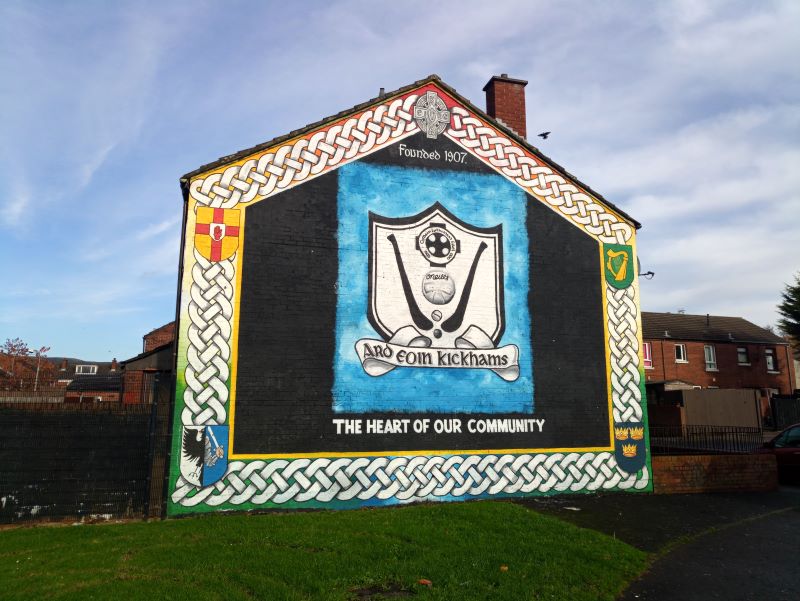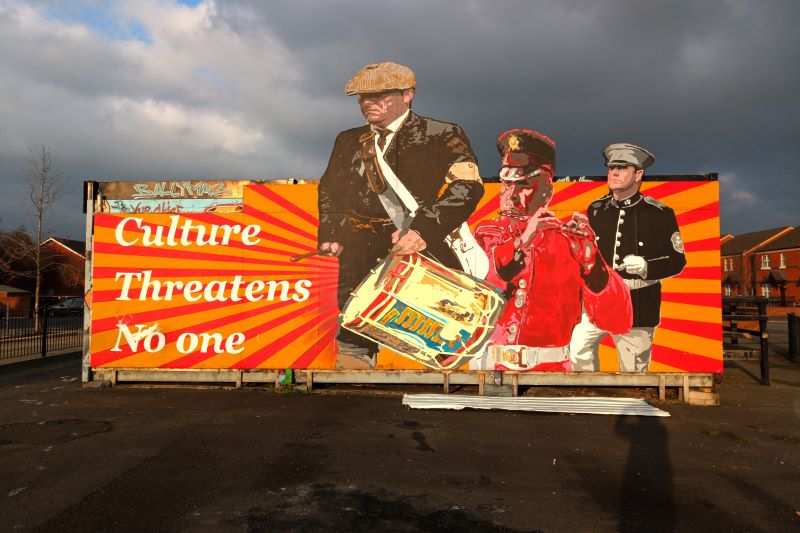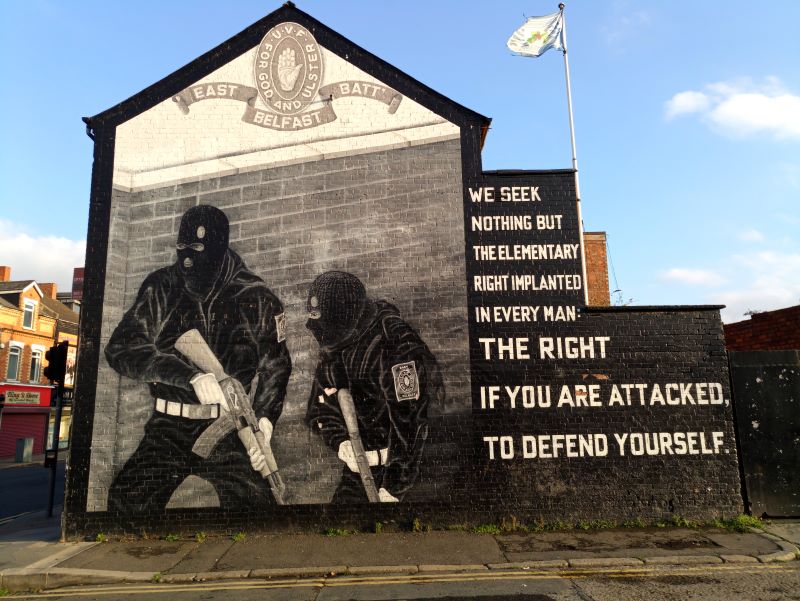When we talk about the conflict in Northern Ireland in the last century, we usually use a simplification when we state that the parties to the conflict at the time were Protestants and Catholics. The reality was, of course, much more complex, but now witnesses of those events are trying to use this difficult history in a narrative that can serve peaceful relations, and, interestingly, also translates into increased tourist interest.
Contact
Prof. Leszek Drong from the Institute of Literary Studies University of Silesia – leszek.drong@us.edu.pl
Republican mural in the Ardoyne district | Photo: Leszek Drong
| Tomasz Płosa |
On 10 April 1998 the governments of the United Kingdom and the Republic of Ireland adopted the Good Friday Agreement. The document, subsequently countersigned by Northern Ireland’s main political parties, symbolically ended 30 years of bloody conflict in the region.
Whom against whom
In the context of the tragic events that have been consuming Northern Ireland since the late 1960s, the parties at war are most often described as Catholics and Protestants, but this is a gross oversimplification. Yes, the denominational component is important, but it is not the only element of the opposing ethno-cultural identities.
On one side we have a Catholic community referring to the Celts and Vikings as their ancestors on the island of Ireland and a republican-minded community dreaming of unification with the independent Republic of Ireland, which has been politically and economically discriminated against for decades. On the other side of the barricade is the Protestant community, privileged in many ways, primarily the descendants of Scottish and English settlers colonising Ulster in the 17th century. Their loyalty to the British Crown is described as unionism. It is also worth noting that among Protestants we can distinguish at least three different groups: the Presbyterians, whose ancestors were mostly Scottish immigrants (in the 2021 census this denomination was declared by 16.6% of the population of Northern Ireland), members of the Church of Ireland, which is essentially a province of the Anglican Church (11.5%), and the Methodists (2.4%).
‘And yet, doctrinally, the Anglican Church is closer to Catholicism than to other Protestant denominations’, says Prof. Leszek Drong, an English Studies expert from the University of Silesia in Katowice, who researches Irish (and especially Northern Irish) culture and literature in connection with the history, politics, and society of the entire region. ‘Let us also be clear that this was never a religious war, as it is sometimes labelled. After all, the disputes were not over dogmatic issues of one kind or another! Given the complexity of the situation, I propose to refer to the conflict as a clash between Irish nationalism and British nationalism, although Catholics and Protestants are certainly useful simplifications’
‘Troubles’? An illegitimate euphemism
According to Prof. Drong, referring to the conflict in which more than 3,500 people (including 1,840 civilians) lost their lives as The Troubles is an unfortunate euphemism and should be avoided. The researcher advocates the use of the name The Conflict, capitalised.
Tensions on the Catholic-Protestant line had been occurring in Ulster with varying strength since the 17th century: in 1689, the troops of Catholic King James II besieged the settlement of Derry, where the Protestants were in power. After the creation of the region of Northern Ireland as part of the United Kingdom after World War I, the local Catholics had to recognise the political and economic supremacy of the Protestants — they had virtually no representation in Stormont, the Northern Ireland Parliament, and the local Prime Minister Sir James Craig coined the famous phrase ‘A Protestant parliament serving a Protestant nation’ in 1924.
In 1969, Derry burst into flames again: the Catholic district of Bogside declared autonomy and incorporation into the Republic of Ireland, which resulted in a siege led by the local police (Royal Ulster Constabulary), made up virtually entirely of Protestants, and the British army, which was called in to help and was initially treated as a peacekeeping force. It is the Derry riots that are considered as the start of the unrest that defined the course of life for the population of Northern Ireland over the next three decades. In the same year, radicals from the Irish Republican Army (IRA) formed what became known as the Provisional IRA (PIRA) and, from 1970 onwards, all its factions began to fight against any manifestations of British statehood (as officials of the Crown — not even postmen were safe!). Perhaps the most well-known event in this period of Northern Irish history was the Bloody Sunday, referred to by the band U2 in the song Sunday Bloody Sunday. On 31 January 1972, during a demonstration in Bogside, soldiers of the British Parachute Regiment shot dead thirteen unarmed men and boys (the fourteenth victim died four and a half months later).
Over time, the Conflict moved beyond the borders of Northern Ireland. The atrocities that were taking place were increasingly appalling to world public opinion, and the United States became involved in resolving the situation — the large size of the Irish diaspora in the US was probably of significance.
Installation in east Belfast (2018) to soften the meaning of traditional Orange Order marches | Photo: Leszek Drong
An agreement. And now what?
An increasing pressure from the international community, the political change in the United Kingdom (Labour came to power), but above all the growing fatigue with the Conflict among the people of Northern Ireland, in which the warring parties found themselves in a clinch (there was virtually no chance for unification with the Republic of Ireland), led to the signing of the Good Friday Agreement on 10 April 1998. The document introduced a number of legal and political changes designed to significantly improve the social relations between Protestants and Catholics. The agreement was adopted in a referendum held across the Emerald Isle in May, and in the autumn the Nobel Peace Prize was awarded to two Northern Irish politicians — John Hume, a Catholic, and David Trimble, a Protestant — the main architects of the agreement…
While everything looked great on paper, the reality proved more complicated. In August 1998, one of the cruellest attacks in the history of the Conflict took place — the detonation of a booby-trapped car by the Real IRA in Omagh killed 29 people (including nine children) and injured over 200 others. The process of disarming the IRA, although assumed in the agreement, did not begin until 2006-2007. On the other side, marches of the Orange Order supporters, i.e. people favouring committing to tightening the relationship with British Crown, have been organised to this day with a distinctly confrontational flavour.
The peace walls are finally standing tall
The fact is, however, that the entire region also felt the very positive effects of the Good Friday Agreement. Almost overnight, EU money began to flow into Northern Ireland and investors began to arrive, mainly from the United States. This interest of foreign capital especially benefited Belfast, which saw the development of its inner city after 1998 and the restoration of the Titanic Quarter shipbuilding area, where Harland and Wolff built the famous Titanic between 1911 and 1912. Northern Ireland became very popular with filmmakers, who increasingly made use of the beautiful scenery of the north of the island (the tax incentives for filming there also play a significant part) — the fans of the Game of Thrones TV series will know that some of the events taking place in the north of Westeros were filmed in the Ulster countryside and in Belfast itself, not far from the Titanic Museum, is the Winterfell Castle set.
The year 1998 also marks a turning point for Northern Irish cinema and literature. Obviously, there had been novels with the Conflict in the foreground or background published before, but after the Agreement people began to look at the painful past somewhat differently. The examples include Eureka Street by Robert McLiam Wilson, published just before the signing of the Good Friday Agreement, Where Are We Now? by Glenn Patterson, 2018 Booker Prize-winning Milkman by Anna Burns, The Truth Commissioner by David Park, and The Ghosts of Belfast by Stuart Neville, which describes the city in the period immediately after the agreement.
Mural in east Belfast referring to the activities of paramilitary organisations
during the Conflict | Photo: Leszek Drong
‘Research-wise, I see the transformation of Belfast as a certain reinterpretation of the city. For it is worth pointing out that the city’s past and its history depend to a large extent on how we present these issues to tourists, including those who know nothing about it, and what kind of framework we propose for the story we want to tell’, explains Prof. Leszek Drong.
A very interesting thing happened after 1998; both Catholics and Protestants started to use Belfast’s past to attract tourists, including the bombers associated with each side, now released from prison. One form of tours offered in the city, for example, is the old-style taxi tours, whose driver, often with a criminal past, is also the guide. He tells the story of Belfast, referring to his own experiences and chooses the route according to the ‘plot’ of his own life. Thus, someone named Seamus, Séan, or Cilian will take a route commemorating the martyrdom of the Catholic community, while James, John, or Stuart will choose the sites of importance to Protestants.
Moreover, the two routes will very often intersect at locations that are either neutral or important to both communities. Another manifestation of the specific shaping of the Northern Ireland capital’s memory is the retention of the so-called peace walls, i.e. fences built over the years to separate the feuding sides — the longest such fence separates the Protestant Shankill Road from the Catholic Falls Road in the western part of the city. And while the walls of peace are a visible sign of the tragedy that played out in the past, there is a prevailing awareness that this is also a popular tourist attraction. This is why neither Protestants nor Catholics dismantle them, despite encouragement from the politicians. In this context, Belfast is a destination for dark tourism, which is all about extreme, violent experiences that evoke memories of dramatic events.
Everything that happened in Belfast after 1998 is a fascinating example of a peace process and gradually established consensus allowing the inhabitants of the change-oriented city to jointly benefit from the opportunities opening for them.
The article titled ‘Belfast – a reinterpretation of the city’ appeared in the popular science journal of the University of Silesia ‘No Limits’ No. 2(8)/2023.








